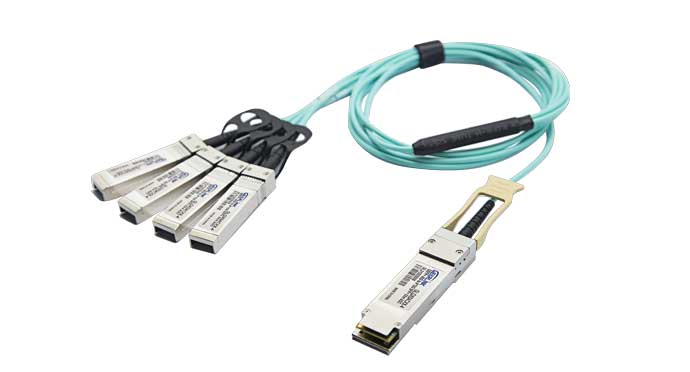AOC refers to Active Optical Fiber which requires optical transceiver devices to convert electrical signals into optical signals, or convert optical signals into electrical signals. AOC cables have the advantages such as high rate, long transmission distance, low consumption, and convenient.
As a professional optical transceiver manufacturer, we also provide a variety of transceivers, for example, 400g transceiver, module sfp 10g, sfp transceiver, 40g transceiver, 25g transceiver, direct attach cable and so on.






850nm VCSEL laser and PIN photo-detector
Low power consumption
Lane bit rate 10.3 Gb/s
Single +3.3V power supply
Hot Plug-gable
Operating case temperature : 0°C to +70 °C
Operating case temperature: -40°C to +80 °C
Digital diagnostics functions are available via the I2C interface
Power consumption per end:<1.0W for QSFP and <0.35W for SFP+
Other optical links
10G Gigabit Ethernet
InfiniBand QDR, DDR, SDR,EDR
High-performance computing clusters
4G and 8G Fibre Channel Applications
Servers, switches, storage, and host card adapters;
25GBASE-SR Ethernet
Servers, switches, storage, and host card adapters
Datacenter
100G Ethernet
40GbE and 10GbE break-out applications for Datacom switch and router connections
40G to 4×10G density applications for Data-com and Proprietary protocol applications
Permanently connecting optical fiber seems simple, but it will produce a lot of technical and cost advantages; Enough to create a new category of interconnected products. Since optics are included in the cable, designers do not have to comply with IEEE or ibta industry standards to achieve interoperability between transceivers and other suppliers. This gives designers complete freedom to choose the lowest cost and best performance technology because the cable is a closed system and has a predefined cable length. All this will lead to a sharp decline in costs and prices. Here are some of the results of this simple change:
Lowest available price optical interconnection: nearly half the price of a single optical transceiver - not just the cost of removing optical connectors.
Plug and play: easy to use cable function - just like DAC cable, only longer optical distance.
Long-distance: up to 100 meters and 200 meters according to technology.
Lowest optical power consumption per end: significantly lower than connector transceivers - saving power consumption and cooling operating costs.
No need to clean and maintain optical connectors: save operating costs and improve reliability.
Optical isolation: isolate the electrical system from the ground loop like a copper DAC cable - Reliability advantage.
GearLink's AOC can be divided into 10G AOC, 25G AOC, 40G AOC and 100G AOC according to the transmission rate.
1. Power consumption: The maximum power consumption of DAC(direct attach cable) is lower than AOC;
2. Transmission distance: The transmission distance of AOC can up to 100M, while DAC is generally about 7M;
3. Transmission medium: The transmission medium of AOC is optical fiber, which belongs to optical communication; and DAC is copper wire, which belongs to electrical; communication.
4. Transmission signals: AOC transmit optical signals but DAC transmits electrical signals.
Active optical cable components can be used for optical backplane, rack to rack, rack to rack interconnection, storage, hub, switch, router, server, etc.
The following is AOC market segmentation by application.
Mainframe/supercomputer (high-performance computing – HPC).
High definition television (HDTV).
Personal computer.
Consumer electronics (CE).
The following is AOC market segmentation by bus interface.
Infiniband – high speed interface bus used in HPC and data center
HDMI – HD multimedia interface
USB – universal serial bus
DisplayPort – bus specification developed by Video Electronics Standards Asso. (VESA)
